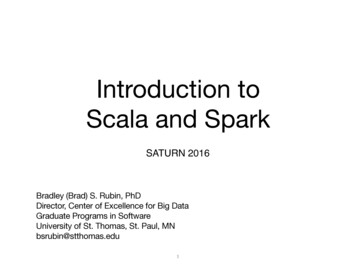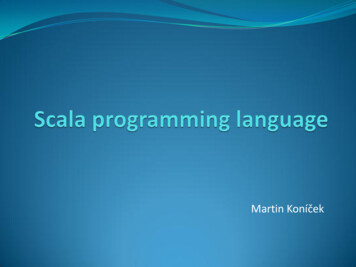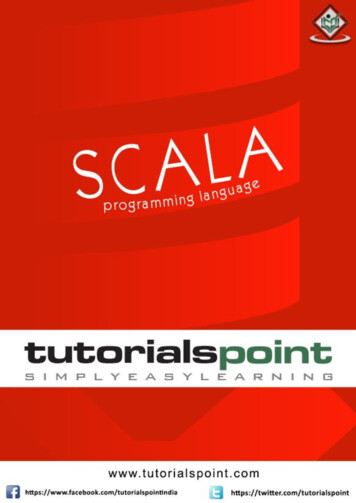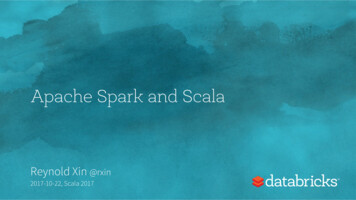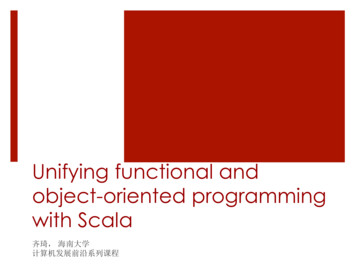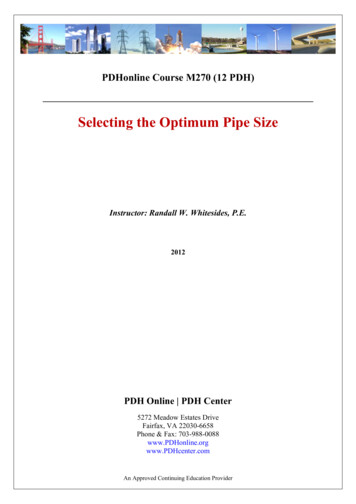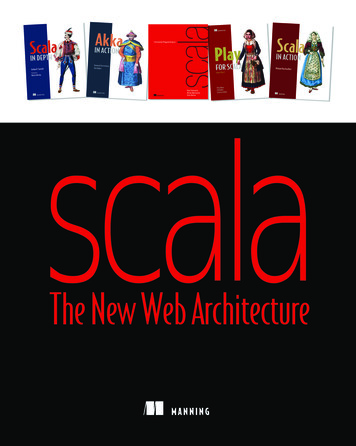
Transcription
Scala: the NewWeb ArchitectureMANNINGSHELTER ISLAND
Save 40% on these great books!Enter Promotional Code 13scalsav when you check out at manning.comClick on covers to learn more or to orderScala in Action is a comprehensive tutorial that introduces Scala throughclear explanations and numerous hands-on examples. Because Scala is a richand deep language, it can be daunting to absorb all the new concepts atonce. This book takes a “how-to” approach, explaining language concepts asyou explore familiar programming challenges that you face in your day-today work.Scala in Depth is a unique book designed to help you integrate Scala effectivelyinto your development process. By presenting the emerging best practicesand designs from the Scala community, it guides you through dozens of powerful techniques example by example.Akka in Action is a comprehensive tutorial on building message-oriented systems using Akka. The book takes a hands-on approach, where each new concept is followed by an example that shows you how it works, how toimplement the code, and how to (unit) test it. You’ll learn to test and deployan actor system and scale it up and out, showing off Akka’s fault tolerance.As you move along, you’ll explore a message-oriented event-driven application in Akka. You’ll also tackle key issues like how to model immutable messages and domain models, and apply patterns like Event Sourcing, andCQRS. The book concludes with practical advice on how to tune and customize a system built with Akka.Functional Programming in Scala is a serious tutorial for programmers lookingto learn FP and apply it to the everyday business of coding. The book guidesreaders from basic techniques to advanced topics in a logical, concise, andclear progression. In it, you’ll find concrete examples and exercises that openup the world of functional programming.
Play for Scala shows you how to build Scala-based web applications using thePlay! 2 framework. This book starts by introducing Play! through a comprehensive overview example. Then, you’ll look at each facet of a typical Play!application both by exploring simple code snippets and by adding to alarger running example. Along the way, you’ll deepen your knowledge ofScala as a programming language and work with tools like Akka and SBT.Play for Java shows you how to build Java-based web applications using thePlay! 2 framework. This book starts by introducing Play! through a comprehensive overview example. Then, you’ll look at each facet of a typical Play!application both by exploring simple code snippets and by adding to alarger running example. Along the way, you’ll contrast Play! and JEE patterns and learn how a stateless web application can fit seamlessly in an enterprise environment. You’ll also learn how a little Scala can go a long way increating tight, efficient Java applications.Scalatra in Action introduces Scalatra and the Sinatra model. It covers theframework in its entirety; starting with concepts such as request routing,input handling, actions, and HTTP responses. It then proceeds to moreadvanced topics, such as data access, handling heavy load, asynchronicity,securing your application, designing and documenting RESTful APIs, andrealtime web programming.The Well-Grounded Java Developer offers a fresh and practical look at newJava 7 features, new JVM languages, and the array of supporting technologies you need for the next generation of Java-based software.Purchase of any print book from Manningincludes free eBook versions in PDF, ePub, and Kindle formatsFor quantities over 20 copies, contact Candace Gillhoolley (cagi@manning.com)for additional discount pricing
Scala: The New Web ArchitectureA special edition eBookCopyright 2013 Manning Publicationswww.manning.com
contentsabout the new web architectureabout this eBookabout the authorsviviiviii1 Functional programming meets object orientation2 Implementing a REST endpoint with Spray3 What is functional programming 194 Consuming JSON 265 Ad hoc polymorphism with type classesv2981
about the new web architectureThe new way to make web applications is here—where data is big, not just its size butthe importance we place on it. More and more companies are mining data for anyuseful tidbits they can find. In the new web, the server is asynchronous and concurrent,both in input and output. Where scaling means using all available cores as well as having multiple servers. Where failure is assumed and acknowledged, not avoided. Wherethe browser is the rich client, and the user experience takes all. This is the new web, andhere are the technologies and techniques to leverage it.This sampler starts off showing the migration in thought from classical object oriented programming into a functional programming (FP) mindset, even among popular technologies today. Next, we’ll take a deep dive into Akka and Spray and see howfunctional composition and the Futures library enable Spray to host a completelyasynchronous REST API on an Akka backend. Now that we’ve seen some FP in action,let’s examine what the words “functional programming” mean, with an excerpt fromPaul and Runar’s “Functional programming in Scala.”Next, we’ll dig into one of the must common techniques in any software shop:munging data. First, let’s look at how the Play framework does typesafe translation to/from JSON and Scala classes. This technique allows the programmer to quickly ingestand make use of data in a safe manner. Then, let’s look at the concept, used widely inFP, that enables better OO design, called “type classes” (or “type traits” in C ). This willallow us to dig into the full power of this concept to design role-based interfaces inour own code.We, as an industry, have a lot to learn from functional programming practices. Thissampler highlights a few small areas of power, and how they enable you to write nextgeneration applications. If you’re interested in writing highly reactive and concurrentsystems, these are the technologies that simplify the problem, and featured in thissampler are some books to help you get started.JOSH SUERETHAUTHOR OF SCALA IN DEPTHvi
about this eBookThis eBook presents five excerpts taken from Manning books—one of them publishedand four that will be published in 2013. Click on the covers to learn more or to order.Scala in DepthJoshua D. SuerethAkka in ActionISBN: 9781935182702304 pages, 49.99May 2012Raymond Roestenburgand Rob BakkerISBN: 9781617291012475 pages, 49.99September 2013Functional Programming in ScalaPaul ChiusanoRúnar BjarnasonISBN: 9781617290657325 pages, 44.99July 2013Play for ScalaPeter Hilton, Erik Bakker,Francisco CanedoISBN: 9781617290794300 pages, 49.99April 2013Scala in ActionNilanjan RaychaudhuriISBN: 9781935182757525 pages, 44.99March 2013Purchase of any print book from Manning.comincludes free eBook versions in PDF, ePub, and Kindle formats
about the authorsJOSH SUERETH is a software developer with Typesafe. He is a Scala committer and themaintainer of scala-tools.org.RAYMOND ROESTENBURG is an experienced software craftsman, polyglot programmer,and software architect. He is an active member of the Scala community, an Akka committer, and contributed to the Akka-Camel module. ROB BAKKER is an experienceddeveloper focused on concurrent back-end systems and system integration. He hasused Scala and Akka in production from version 0.7.PETER HILTON is a senior solution architect at Lunatech Research in the Netherlandsand a committer on the Play! framework. ERIK BAKKER, also at Lunatech, is a Play! module contributor and regularly writes and presents about Play! FRANCISCO CANEDO joinedLunatech in 2005 and has been focused on Scala and Play! for the past two years.PAUL CHIUSANO and RÚNAR BJARNASON are recognized experts in functional programming with Scala. Each has been writing Scala and using FP professionally for severalyears. PAUL is a Scalaz contributor, blogs and speaks regularly on Scala and FP. RÚNAR isa principal contributor to Scalaz and the Functional Java library and has been usingand teaching FP since 2008.NILANJAN RAYCHAUDHURI is a skilled developer, speaker, and avid polyglot programmerwho believes in selecting the right tool for the job.viii
Functional programmingmeets object orientationFrom Scala in Depthby Joshua SuerethFunctional programming and object-oriented programming are two differentways of looking at a problem. Functional programming puts special emphasis onthe “verbs” of a program and ways to combine and manipulate them. Objectoriented programming puts special emphasis on “nouns” and attaches verbs tothem. The two approaches are almost inverses of each other, with one being “topdown” and the other “bottom up.”Object-oriented programming is a top-down approach to code design. Itapproaches software by dividing code into nouns or objects. Each object has someform of identity (self/this), behavior (methods), and state (members). After identifying nouns and defining their behaviors, interactions between nouns are defined.The problem with implementing interactions is that the interactions need to liveinside an object. Modern object-oriented designs tend to have service classes, whichare a collection of methods that operate across several domain objects. Serviceclasses, although objects, usually don’t have a notion of state or behavior independent of the objects on which they operate.A good example is a program that implements the following story: “A catcatches a bird and eats it.” An object-oriented programmer would look at this sentence and see two nouns: cat and bird. The cat has two verbs associated with it:catch and eat. The following program is a more object-oriented approach:class Birdclass Cat {def catch(b: Bird): Unit .def eat(): Unit .}1
2Functional programming meets object orientationval cat new Catval bird new Birdcat.catch(bird)cat.eat()In the example, when a Cat catches a Bird, it converts the bird to a type of Food,which it can then eat. The code focuses on the nouns and their actions: Cat.eat(),Cat.catch(.). In functional programming, the focus is on the verbs.Functional programming approaches software as the combination and applicationof functions. It tends to decompose software into behaviors, or actions that need to beperformed, usually in a bottom-up fashion. Functions are viewed in a mathematicalsense, purely operations on their input. All variables are considered immutable. Thisimmutability aids concurrent programming. Functional programming attempts todefer all side effects in a program as long as possible. Removing side effects makes reasoning through a program simpler, in a formal sense. It also provides much morepower in how things can be abstracted and combined.In the story “A cat catches a bird and eats it,” a functional program would see thetwo verbs catch and eat. A program would create these two functions and composethem to create the program. The following program is a more functional def catch(hunter: Cat, prey: Bird): Cat with Catchdef eat(consumer: Cat with Catch): Cat with FullTummyval story (catch ) andThen (eat )story(new Cat, new Bird)In the example, the catch method takes a Cat and a Bird and returns a new value oftype Cat with Catch. The eat method is defined as taking a CatWithPrey (a cat needssomething to eat) and returns a FullCat (because it’s no longer hungry). Functionalprogramming makes more use of the type system to describe what a function is doing.The catch and eat methods use the type signatures to define the expected inputand output states of the function. The with keyword is used to combine a type withanother. In this example, the traits Catch and FullTummy are used to denote thecurrent state of a Cat. The methods eat and catch return new instances of Catattached to different state types. The story value is created by composing the functions catch and eat. This means that the catch method is called and the result is fedinto the eat method. Finally, the story function is called with a Cat and a Bird andthe result is the output of the story: a full cat.
3Discovering existing functional conceptsTable 1Attributes commonly ascribed to object-oriented and functional programmingObject-oriented programmingFunctional programmingComposition of objects (nouns)Composition of functions (verbs)Encapsulated stateful interactionDeferred side effectsIterative algorithmsRecursive algorithms and continuationsImperative flowLazy evaluationN/APattern matchingFunctional programming and object orientation offer unique views of software. It’sthese differences that make them useful to each other. Object orientation can dealwith composing the nouns, and functional programming can deal with composingverbs. In the example, the functional version was built by composing a set of functions that encompassed a story and then feeding the initial data into these functions.For the object-oriented version, a set of objects was created and their internal statewas manipulated. Both approaches are useful in designing software. Object orientation can focus on the nouns of the system and functional programming can composethe verbs.In fact, in recent years, many Java developers have started moving toward splittingnouns and verbs. The Enterprise JavaBeans (EJB) specification splits software into Session beans, which tend to contain behaviors, and Entity beans, which tend to model thenouns in the system. Stateless Session beans start looking more like collections offunctional code (although missing most of the useful features of functional code).This push of functional style has come along much further than the EJB specifications. The Spring Application Framework promotes a functional style with its Template classes, and the Google Collections library is very functional in design. Let’s lookat these common Java libraries and see how Scala’s blend of functional programmingwith object orientation can enhance these application program interfaces (APIs).Discovering existing functional conceptsMany modern API designs have been incorporating functional ideas without ascribingthem to functional programming. For Java, things such as Google Collections or theSpring Application Framework make popular functional concepts accessible to theJava developer. Scala takes this further and embeds them into the language. To illustrate, you’ll do a simple translation of the methods on the popular Spring JdbcTemplate class and see what it starts to look like in Scala.public interface JdbcTemplate {List query(PreparedStatementCreator psc,RowMapper rowMapper).}Query for list of objects
4Functional programming meets object orientationNow for a simple translation into Scala, you’ll convert the interface into a trait havingthe same method(s):trait JdbcTemplate {def query(psc: PreparedStatementCreator,rowMapper: RowMapper): List[ ]}The simple translation makes a lot of sense but it’s still designed with a distinct Javaflair. Let’s start digging deeper into this design. Specifically, let’s look at the PreparedStatementCreator and the RowMapper interfaces.public interface PreparedStatementCreator {PreparedStatement createPreparedStatement(Connection con)throws SQLException;}The PreparedStatementCreator interface contains only one method: createPreparedStatement. This method takes a JDBC connection and returns a PreparedStatement. The RowMapper interface looks similar:public interface RowMapper {Object mapRow(ResultSet rs, int rowNum)throws SQLException;}Scala provides first-class functions. This feature lets us change the JdbcTemplatequery method so that it takes functions instead of interfaces. These functions shouldhave the same signature as the sole method defined on the interface. In this case, thePreparedStatementCreator argument can be replaced by a function that takes a connection and returns a PreparedStatement. The RowMapper argument can be replacedby a function that takes a ResultSet and an integer and returns some type of object.The updated Scala version of the JdbcTemplate interface would look as follows:trait JdbcTemplate {def query(psc: Connection PreparedStatement,rowMapper: (ResultSet, Int) AnyRef): List[AnyRef]}Use first-class functionsThe query method is now more functional. It’s using a technique known as the loanerpattern. This technique involves some controlling entity (the JdbcTemplate) creatinga resource and delegating the use of it to another function. In this case, there aretwo functions and three resources. Also, as the name implies, JdbcTemplate is partof a template method in which pieces of the behavior were deferred for the user toimplement.In pure object orientation, this is usually done via inheritance. In a more functionalapproach, these behavioral pieces become arguments to the controlling function. Thisprovides more flexibility by allowing mixing/matching arguments without having tocontinually use subclasses.
Examining functional concepts in Google Collections5You may be wondering why you’re using AnyRef for the second argument’s returnvalue. AnyRef is equivalent in Scala to java.lang.Object. Because Scala has supportedgenerics, even when compiling for 1.4 JVMs, we should modify this interface further toremove the AnyRef and allow users to return specific types.trait JdbcTemplate {def query[ResultItem](psc: Connection PreparedStatement,rowMapper: (ResultSet, Int) ResultItem): List[ResultItem]Typed return list}With a few simple transformations, you’ve created an interface that works directlyagainst functions. This is a more functional approach because Scala’s function traitsallow composition. By the time you’re finished reading Scala in Depth, you’ll be able toapproach the design of this interface completely differently.Functional programming also shines when used in a collections library. The Rubyand Python programming languages support some functional aspects directly in theirstandard library collections. For Java users, the Google Collections library brings practices from functional programming.Examining functional concepts in Google CollectionsThe Google Collections API adds a lot of power to the standard Java collections. Primarily it brings a nice set of efficient immutable data structures, and some functionalways of interacting with your collections, primarily the Function interface and thePredicate interface. These interfaces are used primarily from the Iterables andIterators classes. Let’s look at the Predicate interface and its uses.interface Predicate T {public boolean apply(T input);public boolean equals(Object other);}The Predicate interface is simple. Besides equality, it contains an apply method thatreturns true or false against its argument. This is used in an Iterators/Iterablesfilter method. The filter method takes a collection and a predicate. It returns anew collection containing only elements that pass the predicate apply method. Predicates are also used in the find method. The find method looks in a collection for thefirst element passing a Predicate and returns it. The filter and find method signatures are shown in the following code.class Iterables {public static T Iterable T filter(Iterable T unfiltered,Predicate ? super T predicate) {.}Filters using predicatepublic static T T find(Iterable T iterable,Predicate ? super T predicate) {.}Find using predicate.}
6Functional programming meets object orientationThere also exists a Predicates class that contains static methods for combining predicates (ANDs/ORs) and standard predicates for use, such as “not null.” This simpleinterface creates some powerful functionality through the potential combinationsthat can be achieved with terse code. Also, because the predicate itself is passed intothe filter function, the function can determine the best way or time to execute the filter. The data structure may be amenable to lazily evaluating the predicate, making theiterable returned a “view” of the original collection. It might also determine that itcould best optimize the creation of the new iterable through some form of parallelism. This has been abstracted away, so the library could improve over time with nocode changes on our part.The Predicate interface is rather interesting, because it looks like a simple function. This function takes some type T and returns a Boolean. In Scala this would berepresented as T Boolean. Let’s rewrite the filter/find methods in Scala and seewhat their signatures would look like:object Iterables {def filter[T](unfiltered: Iterable[T],predicate: T Boolean): Iterable[T] {.}def find[T](iterable: Iterable[T],predicate: T Boolean): T {.}.}No need for ?You’ll immediately notice that in Scala we aren’t using any explicit ? super T typeannotations. This is because Scala defines type variance at declaration time. For thisexample, that means that the variance annotation is defined on the Function1 classrather than requiring it on every method that used the class.What about combining predicates in Scala? We can accomplish a few of these quicklyusing some functional composition. Let’s make a new Predicates module in Scala thattakes in function predicates and provides commonly used function predicates.The input type of these combination functions should be T Boolean and theoutput should also be T Boolean. The predefined predicates should also have atype T Boolean.object Predicates {def or[T](f1: T Boolean, f2: T Boolean) (t: T) f1(t) f2(t)def and[T](f1: T Boolean, f2: T Boolean) (t: T) f1(t) && f2(t)val notNull[T]: T Boolean ! yntaxWe began to delve into the realm of functional programming. We’re defining firstclass functions and combining them to perform new behaviors. You’ll notice the ormethod takes two predicates, f1 and f2. It then creates a new anonymous functionthat takes an argument t and ORs the results of f1 and f2. Playing with functions alsomakes more extensive use of generics and the type system. Scala has put forth a lot ofeffort to reduce the overhead for generics in daily usage.
7SummaryFunctional programming is more than combining functions with other functions.The essence of functional programming is delaying side effects as long as possible.This predicate object defines a simple mechanism to combine predicates. The predicate isn’t used to cause side effects until passed to the Iterables object. This distinction is important. Complex predicates can be built from simple predicates using thehelper methods defined on the object predicates.Functional programming grants the means to defer state manipulation in a program until a later time. It provides a mechanism to construct verbs that delay sideeffects. These verbs can be combined in a fashion that makes reasoning through aprogram simpler. Eventually the verbs are applied against the nouns of the system. Intraditional FP, side effects are delayed as long as possible. In blended OO-FP, the idioms merge.SummaryScala blends functional and object-oriented programming, although this has beendone in Java as well. Scala made choices about syntax that drastically reduced the verbosity of the language and enabled some powerful features to be elegantly expressed,such as type inference. Finally, Scala has tight integration with Java and runs on top ofthe Java virtual machine, which is perhaps the single most important aspect to makeScala relevant to us. It can be utilized in our day-to-day jobs with little cost.As Scala blends various concepts, users of Scala will find themselves striking a balance among functional programming techniques, object orientation, integration withexisting Java applications, expressive library APIs, and enforcing requirementsthrough the type system. Often the best course of action is determined by the requirements at hand. It’s the intersection of competing ideas where Scala thrives and alsowhere the greatest care must be taken.Here are some other Manning titles you might be interested in:Functional Programmingin ScalaPaul ChiusanoRúnar BjarnasonISBN: 9781617290657325 pages, 44.99July 2013Play for JavaPlay for ScalaCovers Play 2Nicolas LerouxSietse de KaperISBN: 9781617290909325 pages, 49.99April 2012Peter Hilton, Erik Bakker,Francisco CanedoISBN: 9781617290794300 pages, 49.99April 2013
Implementing aREST endpoint with SprayFrom Akka in Actionby Raymond Roestenburgand Rob BakkerAframework that is often used in combination with Akka is the Spray toolkit.This is a lightweight and modular toolkit. So, just as with Akka, you only have toinclude the parts of Spray you actually use. Spray also has its own test kit and is ableto test your code without building a complete application. When you need REST/HTTP support, Spray is a great way to connect your Akka applications to other Systems. This article, based on chapter 8 of Akka in Action, explains how to implementa REST endpoint with Spray.Akka is designed in such way that it can be integrated with any framework. Weare going to show an example how to use Akka with Spray. The example will use aREST interface. REST is a standard protocol to connect different systems or be usedto create a user interface for a system. This is also an endpoint for a system. Spray isan open-source toolkit for REST/HTTP and low-level network IO on top of Scalaand Akka. We start with the example description and then we show you the Sprayimplementation.We are going to implement an order system example. We are also implementinga mockup of our order processing system, so we can see how the endpoint forwardsthe request to the system and waits for the response before returning a response.We are going to do this by implementing one endpoint that uses the REST transport protocol. The overview of this example is shown in figure 1.The example has two interfaces: one between the web shop and the endpointand between the endpoint and the order process. We start by defining the messagesfor both interfaces. The order system will support two functions. The first function8
Implementing a REST endpoint with SprayFigure 19REST example overviewis to add a new order and the second function is to get the status of an order. TheREST interface we are going to implement is a POST and a GET. With the POST, we adda new order to our system, and with the GET, we retrieve the status of that order. Let’sbegin by adding an order. Figure 2 shows the messages and the flow when adding anew order.Figure 2Message flow when adding an orderThe web shop sends a POST request to the endpoint containing XML, and the endpoint translates it to the order message and sends it to the rest of the order processingsystem. On completion, the response is a TrackingOrder object, which contains theorder, a unique id, and the current status. The endpoint translates this to a confirmXML containing the id and status and sends it back to the web shop. In this example,the new order got the id 1 and the status received.Figure 3 shows the messages when getting the status of an order already in theorder system.
10Figure 3Implementing a REST endpoint with SprayMessage flow when getting the status of an orderTo get the status, the web shop will send a GET request with a parameter id, which contains the requested order id, in this case, 1. This is translated to an OrderId. Theresponse of the system is again a TrackingOrder message when the order is found.The endpoint translates this response into a statusResponse XML.When the order isn't found, the system will respond with a NoSuchOrder object, asshown in figure 4.Figure 4Message flow when trying to get the status of an unknown orderWhen the endpoint receives the NoSuchOrder message, the status of the XML responsewould be “id is unknown” and the id is filled with the unknown OrderId.Now that we have defined the messages sent through the system, we implement theProcess Orders component. Figure 5 shows the implementation of the interface we’vealready defined.This is a simple representation of a complete system that implements two possiblerequests. We also added a reset function, which can be used while testing the complete system.Now we are ready to implement the REST endpoint.To give you a feeling of how Spray can help you implement a REST interface, we’regoing to implement a sample REST endpoint using Spray. But, keep in mind this isonly a small part of Spray; there is much more.
Implementing a REST endpoint with SprayFigure 511Implementation of the process ordersThe Spray toolkit uses actors to implement the functionality. Therefore, we start tocreate an actor that extends the Spray HttpService. A good practice is to separate theroute definitions and the actual actor, because this enables you to test the routes without starting the actor. For this, Spray has its own test kit, which enables you to test onlythe route. But, in our example, we do want to use the complete actor environment.Figure 6 shows both the actor and the trait containing the route.Figure 6Endpoint implementation using Spray
12Implementing a REST endpoint with SprayThe trait OrderService contains the route, which defines the REST interface. TheOrderServiceActor is the placeholder and parent Actor of the processing of theSpray components. To make it work, we need to set the actorRefFactory of theHttpService. This is the actor context, which is used when creating the necessarySpray components. And, we need to implement the receive method. Here, we definewhich route we are going to use. This is all what we need to do in the ServiceActor.Our OrderService extends the HttpService and contains all of the functionality ofour REST implementation.In the trait, we define a route. This is the REST interface and defines which messages we except. Defining the route is done by using Directives. You can see a Directive as a rule the received messages should match. A Directive has one or mor
Functional Programming in Scala is a serious tutorial for programmers looking to learn FP and apply it to the everyday business of coding. The book guides readers from basic techniques to advanced topics in a logical, concise, and clear progression. In it, you’ll find co ncrete examples and exercises
